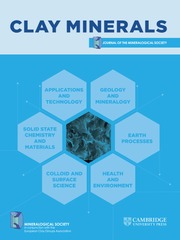No CrossRef data available.
Article contents
Hydration of alkali and alkaline-earth montmorillonites: an experimental comparative study from X-ray diffraction, water sorption isotherms and mid-infrared spectroscopy
Published online by Cambridge University Press: 06 August 2025
Abstract
This study investigates the influence of interlayer cations on the thermodynamics and sorption mechanisms of water in a reference Wyoming montmorillonite. The behaviour of the montmorillonite exchanged with monovalent cations (Li+, Na+, K+, Rb+, Cs+) or divalent cations (Mg2+, Ca2+, Ba2+) is compared. The analysis combines X-ray diffraction (XRD), water sorption isotherms at various temperatures and mid-infrared spectroscopy. Li+, Mg2+ and Ca2+ promote greater water uptake and swelling, whereas K+, Rb+ and Cs+ significantly limit these processes. The behaviour of Na+ and Ba2+ stands out, demonstrating intermediate water uptake and high swelling. Mid-infrared spectral analysis supports these observations. It is shown that a cation’s effect on water uptake and swelling correlates best with the product of its elementary charge and ionic radius rather than with other properties such as the electrostatic potential, solvation enthalpy or chemical hardness. However, differences in isotherm shapes, hysteresis between adsorption and desorption and the variation of isosteric heat with water content suggest the presence of two distinct sorption mechanisms: one involving Li+, Cs+, Mg2+, Ca2+ and Ba2+, and another involving Na+, K+ and Rb+. These findings indicate that isotherm shape and swelling alone do not directly reflect water uptake capacity. These findings thus outline that the chaotropic (structure-breaking) or kosmotropic (structure-making) nature of the cations, along with the complex interplay between cation hydration and TOT layer attraction, may explain the complex observed differences.
Keywords
Information
- Type
- Article
- Information
- Copyright
- © The Author(s), 2025. Published by Cambridge University Press on behalf of The Mineralogical Society of the United Kingdom and Ireland.

